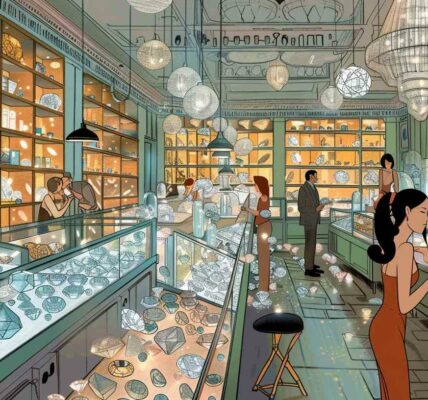De Beers Chief forecasts a positive recovery in the diamond market, despite facing significant economic challenges. The industry's resilience is shown through strategic adaptations, such as adjusting supply levels to balance prices and manage stock. Revenue has fallen, partly due to the competition from lab-grown diamonds and changing consumer preferences. However, analysts are optimistic, expecting market growth from $2.43 billion in 2023 to $2.59 billion in 2024. The global diamond scene is also changing, with trends towards personalised jewellery and sustainability. India's prominent role, processing most rough diamonds, is essential in shaping these dynamics. Uncover more about these developments.
Article Contents
- 1 Main Highlights
- 2 Market Recovery Predictions
- 3 Challenges in 2024
- 4 Analyst Insights
- 5 Global Market Trends
- 6 India's Role
- 7 Future Outlook
- 8 Frequently Asked Questions
- 8.1 What Is De Beers' Approach to Marketing Natural Diamonds?
- 8.2 How Do Sanctions on Russian Diamonds Affect Global Supply?
- 8.3 What Technologies Are De Beers Investing in for Future Growth?
- 8.4 How Does De Beers Plan to Manage Rising Operational Costs?
- 8.5 What Role Does China's Economy Play in Diamond Market Recovery?
- 9 Conclusion
Main Highlights
- De Beers is adjusting supply levels to stabilise prices amidst market challenges.
- Analysts predict early recovery stages in the diamond market due to price stabilisation trends.
- De Beers faces a 21% revenue decline, attributed to economic pressures and changing consumer behaviour.
- Increased competition from lab-grown diamonds is impacting traditional diamond producers.
- Sanctions on Russian diamonds contribute to market volatility, prompting strategic production adjustments.
Market Recovery Predictions
The diamond industry is navigating a path towards recovery, supported by strategic supply constraints and evolving consumer preferences. Companies such as De Beers and Alrosa are making deliberate supply adjustments, which are essential in stabilising prices and setting the stage for a gradual economic recovery. This approach addresses the existing excess stock, providing a foundation for future growth. With supply adjustments essential, the focus remains on demand recovery as the crucial factor for a meaningful market rebound.
Market innovations are also playing a significant role in shaping recovery predictions. The incorporation of AI in diamond grading and an increased focus on sustainable sourcing reflect an industry adapting to contemporary demands. These innovations, coupled with a growing trend towards customisation, are redefining consumer preferences, particularly with the rising interest in lab-grown diamonds. This shift indicates a broader transformation within the market, aligning with an audience keen for freedom of choice and ethical consumption. As consumer interest in fancy-colour diamonds such as pink, red, and blue increases, it further diversifies the market's appeal and potential for growth.
The forecast projects significant growth, with the market expected to climb from $2.43 billion in 2023 to $2.59 billion in 2024.
As China's economic recovery gains momentum, it will be instrumental in driving global demand, marking a hopeful resurgence in the diamond market.
Challenges in 2024
In 2024, the diamond market faces significant challenges, primarily marked by a 21% revenue decline for De Beers, reflecting broader economic pressures and shifts in consumer behaviour. The industry must navigate operational cost pressures while addressing decreased production and sales, as rough diamond sales have plummeted by 22% year-on-year. With the trading price for one-carat natural diamonds at a historic low of £1,400, the market is under immense pressure to stabilise. These difficulties are compounded by increasing competition from lab-grown diamonds, urging traditional diamond producers to innovate and adapt swiftly to sustain market relevance. Additionally, the company's production has decreased from 16.5 million carats to 13.3 million carats, emphasising the need for strategic adjustments to address these market difficulties.
Revenue Decline Analysis
Facing a complex array of challenges, the diamond market is grappling with a significant revenue decline in 2024. De Beers, a leading player in the industry, reports a notable 21% reduction in total revenue, shrinking from $2.8 billion in the initial half of 2023 to $2.2 billion in the same period of 2024. This downturn is attributed to a variety of factors impacting revenue sources, including a global decrease in diamond demand and heightened competition from lab-grown diamonds. In response, De Beers is revisiting its sales strategies, seeking creative ways to bolster demand amidst economic uncertainties in key markets like China and the US. The decline in rough diamond sales, a core revenue source, has been significant, with a 22% year-on-year drop. Despite stable worldwide prices, challenging market conditions persist, prompting De Beers to recalibrate its production strategy, cutting guidance by three million carats. In an effort to manage the ongoing oversupply, focus has shifted to processing existing surface stockpiles at Orapa. Furthermore, the company has launched the DiamondProof technology to differentiate natural diamonds from lab-grown counterparts. Collaborative marketing efforts with leading jewellery retailers aim to rejuvenate interest in natural diamonds, as De Beers anticipates a gradual recovery in sales, underscoring the importance of adaptive sales strategies in this evolving landscape. Geopolitical tensions and financing shifts pose additional challenges for the industry, further affecting market stability and supply chains.
Operational Cost Pressures
What are the key operational cost pressures facing the diamond industry in 2024? The diamond industry is grappling with several challenges, particularly stemming from declining global demand and economic uncertainties in major markets like China and the US. These factors are exacerbated by competition from lab-grown diamonds, putting pressure on natural diamond sales. As a result, companies like De Beers face increased cost control challenges, with higher unit costs and significant inventory management hurdles due to an oversupply in the midstream sector. Prolonged depressed consumer demand in China is a significant factor impacting sales and revenue, further contributing to these pressures. Sanctions on Russian diamonds are also impacting the global market, leading to increased volatility in diamond prices.
| Pressure Point | Impact |
|---|---|
| Global Demand Drop | Decreased revenue and sales volumes |
| Economic Uncertainty | Low consumer confidence |
| Lab-Grown Rivalry | Reduced natural diamond demand |
| Inventory Buildup | Affects profitability |
| Cost Per Carat | Increased due to lower sales |
To navigate these turbulent waters, De Beers has adjusted production levels, forecasting a reduction in carat output by 3 million for 2024. This strategic move aims to balance demand and supply while controlling costs. Furthermore, the "Origins" strategy seeks to streamline operations, targeting a $100 million annual cost reduction. Effective inventory management and strategic marketing are pivotal as the industry seeks to recover and thrive amidst ongoing operational pressures.
Analyst Insights
Analysts are closely monitoring price stabilisation trends in the diamond market, noting that recent signs of stabilisation may hint at early stages of recovery. The effects of production curtailment have also become a focal point, as reduced supply helps balance the market, contributing to these stabilisation efforts. Despite these challenges, the diamond industry's historical resilience suggests that recovery is possible within 12 to 18 months following a crisis. The diamond market is facing challenges, as shown by a 23% decrease in De Beers' production year-on-year to 6.9 million carats in Q1 2024. Meanwhile, China's significant drop in demand remains a critical factor, with its recovery being pivotal for the industry's comprehensive resurgence.
Price Stabilisation Trends
Natural diamond prices are ultimately stabilising following a volatile correction period that succeeded the post-pandemic surge. This stabilisation is largely driven by supply dynamics and demand fluctuations, which have played significant roles in shaping the current market landscape. As the midstream sector strategically manages inventory levels, avoiding the pitfalls of excessive stockpiling, a more balanced market environment emerges. The shortage of rough diamonds, coupled with a decline in imports and a notable increase in polished diamond exports, signals a healthier equilibrium. From the end of August into September, signs of price stabilisation became evident. The average price per carat remains consistent despite a dip in sales volume, confirming a steadier market. Polished diamond prices are showing signs of stability, though shortages persist in specific segments like pointers and smaller goods. De Beers sold rough diamonds worth $130 million in November, which is significantly lower than the $360 million average in 2023, underscoring the impact of supply constraints on the market. With emerging markets such as Switzerland and Oman showing significant growth in cut and polished diamond exports, the industry is witnessing a diversification of demand sources. Global retailers, anticipating increased demand, are likely to place more orders for natural diamonds, further reinforcing market stability. The industry's roadmap to recovery hinges on a resurgence in demand, particularly from China, and the expected enhancement from the holiday season. With supply adjustments being essential, industry stakeholders continue to navigate the complexities of achieving long-term market balance.
Production Curtailment Effects
While price stabilisation has brought a semblance of balance to the diamond market, production curtailment remains a critical factor in traversing the current economic landscape. Major players like De Beers and ALROSA have opted to stockpile inventory as a strategic response to curtailed rough selling, indicative of a refined approach to supply chain and inventory management.
- Global natural diamond production is expected to drop to 117.5 million carats in 2024, a significant decrease from previous years, highlighting the industry's cautious stance amid market uncertainties.
- De Beers has announced a reduction in its 2024 production plan by 3 million carats, emphasising the need to balance supply with the subdued demand to prevent oversupply in the manufacturing sector.
- The preference to reduce supply rather than slash prices underscores a strategic effort to uphold the value of diamond sales, ensuring sustainability in a volatile market.
- G7 sanctions on Russian diamonds present potential long-term supply disruptions, illustrating the intricate dynamics of global inventory management and its ripple effects across the market. The diamond industry has seen a 20% drop in rough diamond production since 2019, impacting the availability of medium and large diamonds that constitute a significant portion of the market's value.
With the industry facing a potential spillover of modest supply overhang from 2023 into 2024, these challenges underscore the complexity of managing diamond inventories effectively.
The industry's proactive measures in production adjustment demonstrate a commitment to maintaining market equilibrium, albeit amidst challenging conditions.
These strategies reflect a broader understanding of the importance of aligning supply with demand to navigate economic headwinds effectively.
China's Demand Impact
How is China's diamond market adapting to shifting economic and cultural landscapes? China's diamond market, the world's second-largest with a value of USD 8.8 billion in 2022, is experiencing significant changes. Cultural shifts, such as declining marriage rates and evolving consumer behaviour, have influenced diamond demand. The market is primarily driven by women's demand, which accounts for a substantial 97% of total diamond jewellery purchases. Yet, a gap persists between purchase intention and actual buying behaviour, highlighting an opportunity for industry adaptation. As the market evolves, younger generations are increasingly interested in personal development over traditional marriage, contributing to reduced engagement ring demand. Despite these challenges, rising prosperity over the past two decades has continued to support the demand for gemstones, including diamonds.
| Factor | Impact | Trend |
|---|---|---|
| Marriage Rates | Declining | Decreased diamond demand |
| Lab-grown Diamonds | Rising popularity | Preferred by younger buyers |
| Consumer Preferences | Shift to experiences | Less focus on material goods |
| Coloured Diamonds | Increasing demand | Popular among the elite |
Lab-grown diamonds' affordability appeals to younger consumers, while social media platforms like Xiaohongshu promote their value. Macro-economic challenges, including a 50% decline in diamond sales, have further impacted demand. As economic headwinds persist, retailers are adapting by adjusting inventories and focusing on new consumer trends. This evolving landscape suggests that the diamond industry must innovate and engage with China's changing market dynamics to drive future growth.
Global Market Trends
Amidst a landscape marked by both opportunities and challenges, the global diamond market is poised for recovery, driven by evolving consumer preferences and regional dynamics. The market, estimated at USD 41.49 billion in 2024, is segmented by type, jewellery making, and industrial applications, with jewellery making remaining a key driver. The diamond market is expected to grow due to rising demand for luxury goods, as supported by increased disposable income in emerging markets. The growth rate is anticipated at a CAGR of 3.3% from 2025 to 2030, buoyed by shifts in market segmentation and consumer preferences. Despite the rough diamond prices dropping by 35% in the past year, industry experts are optimistic about a potential rebound in consumer demand.
Key trends influencing this rebound include:
- Customisation and Personalisation: There is an increasing appetite for custom and personalised diamond jewellery, reflecting a shift towards individuality.
- Ethical and Sustainable Sourcing: Consumers are showing a preference for ethically sourced and sustainable diamonds, aligning with broader environmental concerns.
- Vintage and Secondhand Diamonds: A growing interest in vintage and secondhand diamonds offers a unique appeal, catering to eco-conscious buyers seeking history and sustainability.
- Artificial Intelligence: The integration of AI in diamond grading is transforming the industry, promising greater precision and efficiency.
As Asia Pacific emerges as the second-largest market, driven by millennial demand, and Central & South America shows significant growth potential, the global diamond industry is setting its sights on a promising future.
India's Role

India's pivotal role in the global diamond industry is underscored by its substantial contributions to diamond cutting, polishing, and export activities. As the world's leading diamond processing hub, India handles over 90% of rough diamonds and exports 75% of polished diamonds globally. Central to this prowess is Surat, Gujarat, often dubbed the "diamond capital" of the world, where Indian artisans skilfully transform rough stones into gems of brilliance. The nation's influence extends beyond processing; Indian businesses control significant parts of the global diamond trade, with 29 of De Beers' 75 sight holders being Indian. This strong presence in key trade centres like Dubai and Antwerp emphasises India's strategic importance in the diamond supply chain. With over 10 million skilled diamond cutters and artisans employed in the industry, India's workforce is a critical component in maintaining the country's competitive edge in diamond processing. However, challenges loom. The global shift towards sustainability and geopolitical tensions, such as the G7 ban on Russian diamonds, pressure India's market. Despite this, opportunities abound. Expanding into new markets, coupled with sustainable practices, could improve diamond exports. Initiatives like the Surat Diamond Bourse, which offers cutting-edge facilities, aim to further India's competitive edge, streamline operations, and elevate exports. As India adapts to these dynamics, its artisans and exporters remain pivotal to the industry's resilience.
Future Outlook
The future outlook for the diamond market is cautiously optimistic, as industry players like De Beers anticipate a gradual recovery in the coming years. This recovery is expected to be bolstered by several key factors and strategic adjustments within the industry.
- Sustainability initiatives: De Beers is focusing on sustainability initiatives, aiming to improve the long-term viability of natural diamonds.
- Technology investments: Significant technology investments are being made to improve efficiency and innovation in diamond production.
- Shift in sales mix: There is a notable shift towards higher-value goods, suggesting an improvement in the market for rough diamonds above two carats.
- Supply-side adjustments: Major players are reducing supply to stabilise prices and support market recovery. A slump in sales figures has impacted overall industry revenue, highlighting the need for strategic supply management.
Despite the cautious optimism, challenges remain. Weak economic growth in key markets, such as China and the US, continues to pose risks. High inventory levels and competition from lab-grown diamonds further complicate the landscape.
However, a meaningful recovery in demand, particularly from China, is vital for a sustained rebound. As the industry adopts sustainability and technology, it prepares to navigate these challenges, offering hope for resilience and growth in the diamond market's future.
Frequently Asked Questions
What Is De Beers' Approach to Marketing Natural Diamonds?
De Beers' approach to marketing natural diamonds emphasises sustainable sourcing and luxury branding, appealing to consumers' desire for ethical luxury. They utilise storytelling and tradition, ensuring diamonds symbolise elegance and commitment while promoting responsible environmental and social practices.
How Do Sanctions on Russian Diamonds Affect Global Supply?
The sanctions' impact on Russian diamonds considerably alters the global supply chain, causing potential shortages and increased prices. This disruption encourages diversification of sourcing and improves opportunities for alternative suppliers, fostering a more resilient and independent market environment.
What Technologies Are De Beers Investing in for Future Growth?
De Beers is investing in sustainable mining technologies and traceability solutions, incorporating advanced methods to improve efficiency and reduce environmental impact. Furthermore, they are exploring lab-grown diamonds to diversify offerings and adapt to evolving market preferences.
How Does De Beers Plan to Manage Rising Operational Costs?
Like a skilled sailor steering through turbulent waters, De Beers employs cost management strategies to improve operational efficiency. By optimising mine planning, investing in automation, and harnessing digitalisation, they aim to manoeuvre through rising operational costs towards profitability.
What Role Does China's Economy Play in Diamond Market Recovery?
China's economic trajectory is pivotal in the diamond market's recovery, as its luxury spending patterns and demand influence global dynamics. Sustained growth and renewed consumer confidence in China could stimulate increased diamond purchases, bolstering market resilience.
Conclusion
The diamond market, akin to a resilient ship steering through stormy seas, is projected to recover despite facing significant challenges in 2024. Analysts suggest that global market trends and the essential role of India will play significant parts in this resurgence. While headwinds remain, strategic adjustments and market dynamics are expected to guide the industry towards a brighter horizon. The future outlook remains cautiously optimistic, underscoring the potential for adaptation and growth within this constantly changing sector.




